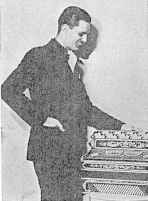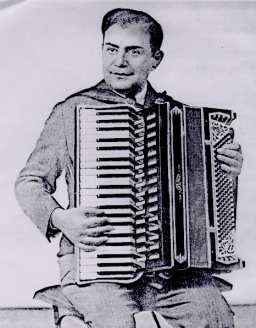

Accordionists today seem to know very little of that accordion jazz genius, who was Cornell Smelser, known professionally by his first name, Cornell. This is because he has been lost to the accordion musical scene for so many years when illness, tuberculosis, in mid 1931 prevented continuance of his career. The articulations, inflections, phrasing, and ever-fresh inventiveness of his improvisations, coupled with his "Superior" accordion with an unusually rich and beautiful tone, brought the realization to listeners that here was a "musician's musician." An accordion-voice executing jazz in a beautiful manner seldom heard.
Significantly, to this day, Cornell has been the only accordionist to be unreservedly accepted by other jazz instrumentalists as "one of them."
First appearing as an accordionist on the jazz scene somewhere in the late 1920's, he blazed across the jazz firmament like a meteor, only quick to vanish, in mid 1931, as quickly as he first appeared.
Cornell Smelser was born on August 7th, 1902, in Budapest, Hungary. Piano was his original instrument and he received his musical education at the Conservatory of Music in Budapest. He finished at 16 and almost immediately began his career as a member of a local orchestra. At 18 he already directed an orchestra of 26 men.
He came to New York in 1920, and from this period until the latter 1920's he played in a "nickelodeon", vaudeville acts, Broadway productions, (becoming also director of some of the musical plays,) musical comedies, hotels, and theater pit orchestras, not to mention an occasion at Carnegie Hall, playing in a symphony with no conductor!
Once in 1924 he played in Florida for J.D. Rockefeller, Sr., receiving the usual emolument of ten cents. By 1927 he had formed his own orchestra to play at the exclusive Beaux Arts Cafe in New York, described in the March 1927 "Orchestra World", with photo on the cover.
At this time his pianistic prowess was such that critics were wondering why he did not enter concert work. Cornell, however, found the "popular" field probably more to his liking and also more remunerative. His photo adorns the covers of at least a dozen song hits of the latter 1920's, and later in 1930 he himself wrote several hit songs which were recorded by many orchestras and singers, such as "Laughing at Life", "Accordion Joe", (Mills Music Co.) "I hate Myself for Falling in Love With You, and others.
Shortly before, Cornell had developed a serious infatuation for the fascinating accordion, with the result that he practiced on it very intensely and constantly, so that with his inherent consummate musicianship it was not long before he became the favorite jazz-accordionist in New York and sough after for the choicest, most select jazz recording and radio dates with orchestras.

In his radio work, Cornell had by 1931 attained to the giddy total of 37 commercial programs per week! Among these were the RKO Theatre of the Air, Gold Medal Fast Freight, Campbell Soup, and Ludwug Bauman Hours. And on the historical evening of April 20th, 1931, Cornell became the first accordionist to be heard as a soloist with accompaniment of an orchestra of symphonic proportions when he played in its entirety, "Rhapsody in Blue" by George Gershwin. Over the NBC national network on the Gold Medal Fast Freight Hour, accompanied by the Ohman Arden Orchestra of some 40 musicians. Of special note was the fact that Cornell was the only accordionist given special permission by Gershwin himself to play this work on the air. Paul Whiteman's Orchestra, the organist Jesse Crawford, and pianist Gershwin himself were the only other musicians permitted to broadcast "Rhapsody" at that time.
On Cornell's recordings with jazz orchestras we find him consistently tasteful, interesting, and modern. An unexpected melodic turn here, a jeweled phrase there, a breath-taking curve, an unpredictable harmonic twist, "chord stars", spicy uses of fourths and fifths, - all such strokes of genius abound. His choice of notes was admirable, and he possessed a beautifully seductive rhythmic subtlety. He knew how to space his notes knowing the emotional value of silence as well as utterance. Occasional fascinating dissonances brought out all the more the beauty of intriguing consonant harmonies. His feeling and instinct for dynamics is a joy to hear, and his bellows accenting of certain notes gives added drive and lift to his ideas. Musically literate, Cornell, when executing a jazz-statement, properly punctuated his phrase sentences, giving meaning and sense. The keys of his accordion gave their sounds to his own personal wishes.
Listeners to Cornell's records today hear "the touch of a vanished hand", and although is solo choruses are of but short duration, "eternity affirms these conceptions of a minute."
Of Cornell's records with orchestras that I have so far found, I am here listing 13 selected representative records and, where known, the names of other famous featured orchestral personnel.
1. "Accordion Joe" by Cornell, and "Double Check Stomp" by Duke Ellington's Orchestra on Brunswick 4783 and 6846. In 1943 "Double Check Stomp" was re-issued (backed with "Jolly Wog") on 80035 in an album called "Harlem Jazz", B-1009. On this re-issue is listed the entire personnel of 13 men, Cornell heron called "Joe" Cornell, probably because he wrote "Accordion Joe." Others featured on these two sides are Johnny Hodges (alto sax,) Cootie Williams (trumpet), Harry Carney (bari sax), and Wellman Braud (string bass.)
2. "Birmingham Bertha", by Jean Goldkette's Orchestra on Victor 22077. (Just as Duke Ellington's Orchestra was the best Negro jazz band, so was Jean's considered the best of the white jazz bands.) Other principal featured players were a clarinet, alto sax, and trumpet, whose identities still await verification, however, as the personnel often changed. All the following were compromised of various all-star New York radio studio jazz personnel.
3. "Accordion Joe" and "Collegiate Love" by Cornell and his orchestra on Okeh 41386 and Odeon 36069. (Parlophone R-785 Cornell's "Collegiate Love" was backed on the reverse side by Louis Armstrong's Orchestra playing "Rocking Chair.") On this session Cornell used Jimmy Dorsey (clarinet and alto sax), Jack Teagarden (trombone), Adrian Rollini (bass sax), Irving Brodsky (piano), and probably Mannie Klein (trumpet). And Artie Dunn (today vocalist organist with the "Three Suns") sang the vocal on "Accordion Joe."
4. "High and Dry" by Irving Mill's Hotsy Totsy Gang on Brunswick 4920. With Jummy Dorsey (clarient and sax) Tommy Dorsey (trombone) Babe Russin (sax) Sterling Bose and Phil Napoleon (trumpets) Gene Krupa (drums) and Hoagy Carmichael (vocal.)
5. "Baby's Birthday Party" by the New York Syncopators on Okeh 41472. The same version is also on Harmony 1239 by Lloyd Keating's orchestra. Here Cornell reveals an astonishingly fleet technique. A trumpet is also featured.
6. "Sing a Little Jingle" by the Knickerbockers (said to have been one of the groups of recording-director Ben Selvin) on Columbia 2483. A trumpet is also featured.
7. "When You Were The B'ossom of Buttercup Lane" by Fred Rich's Orchestra on Columbia 2387. Piano and Guitar are also heard.
8. "Little Girl" by Freddie Rich's Radio Orchestra on Hit of the Week J4. Also featured are Joe Venuti (violin) Eddie Lang (real name was Salvatore Masarao, on Guitar) and trumpet, trombone, and piano are heard.
9. "It's The Girl" by Freddie Rich's Radio Orchestra on Hit of the Week K1. Also featured are Joe Venuti (violin) Eddie Lang (guitar) and piano and trombone. 10. "Sharing" by Andy Sanella's Orchestra on Hit of the Week F2-3. Guitar, trumpet and trombone are also heard.
11. "Sweet Jennie Lee" by Reser's Radio Band on Hit of the Week 1122. Others principally featured are trumpet and tenor sax.
12. "The Peanut Vendor" by the Rumba Orchestra on Harmony 1270. Hereon Cornell is highlighted, behind the vocal, in some of the most brilliantly authentic and beautiful "south of the border" improvisations and fill-ins any musician could possibly ask for. His name is also on the label.
The appearance of Cornell on the accordion horizon was the appearance of an extremely rare genius, and although his fate was to shine as the most beautiful star in the modern music firmament for only a short period, he has already attained immortality in the minds and hearts of those who loved the way he could play an accordion.
The Classical Free-Reed, Inc. staff gratefully acknowledges volunteer Benjamin Lang who assisted in the production of this article, as well as Stanley Darrow and the comprehensive American Accordion Musicological Society library.
| Invitation to Contributors / Submission Guidelines |
| Back to The Free-Reed Journal Contents Page |
| Back to The Classical Free-Reed, Inc. Home Page |